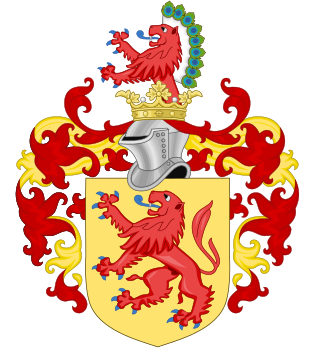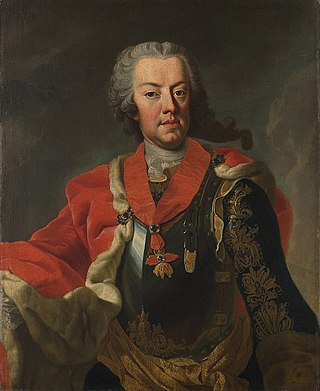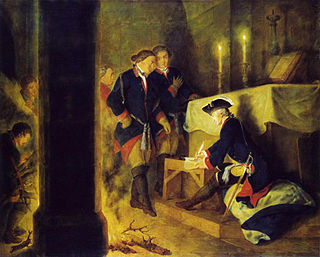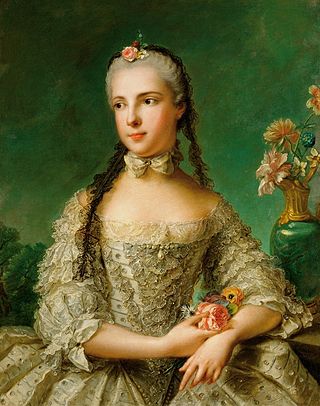Contents
| |||||
| Decades: | |||||
|---|---|---|---|---|---|
| See also: | Other events of 1760 List of years in Austria | ||||

Events from the year 1760 in Austria
| |||||
| Decades: | |||||
|---|---|---|---|---|---|
| See also: | Other events of 1760 List of years in Austria | ||||

Events from the year 1760 in Austria
| | This section needs expansion. You can help by adding to it. (October 2015) |
| | This section needs expansion. You can help by adding to it. (October 2015) |
| | This section needs expansion. You can help by adding to it. (October 2015) |

The House of Habsburg, also known as the House of Austria, was one of the most prominent and important dynasties in European history.

Prince Charles Alexander Emanuel of Lorraine was a Lorraine-born Austrian general and soldier, field marshal of the Imperial Army, and governor of the Austrian Netherlands.

The Battle of Kolín (Kolin) on 18 June 1757 saw 54,000 Austrians under Count von Daun defeat 34,000 Prussians under Frederick the Great during the Third Silesian War. Prussian attempts to turn the Austrian right flank turned into piecemeal frontal attacks and were defeated in five and a half hours of combat. The Prussians lost 13,733 men, the Austrians 8,100. Frederick gave up the siege of Prague as well as his planned march on Vienna and retreated to Saxony.

The Battle of Breslau was fought on 22 November 1757 in Breslau during the Third Silesian War. A Prussian army of 28,000 men fought an Austrian army of 60,000 men. The Prussians held off the Austrian attack, losing 6,000 men to the Austrians' 5,000 men. But one day later the Prussians beat a retreat. Breslau's garrison surrendered on 25 November 1757.

The Battle of Maxen was a battle at Maxen, in the Electorate of Saxony during the Third Silesian War. It resulted in surrender of a Prussian corps.

In the Battle of Torgau on 3 November 1760, King Frederick the Great's Prussian army fought an Austrian army under the command of Field Marshal Leopold Josef Graf Daun. The Prussians won a costly victory in one of the bloodiest battles of the Third Silesian War.

Archduchess Louise of Austria was by marriage Crown Princess of Saxony as the wife of the future King Frederick Augustus III.

The Walhalla is a hall of fame that honours laudable and distinguished people in German history – "politicians, sovereigns, scientists and artists of the German tongue"; thus the celebrities honoured are drawn from Greater Germany, a wider area than today's Germany, and even as far away as Britain in the case of several Anglo-Saxon figures. The hall is a neo-classical building above the Danube River, in Donaustauf, east of Regensburg in Bavaria, the exterior modelled on the Parthenon in Athens.

Count Leopold Joseph von Daun, later Prince of Thiano, was an Austrian field marshal of the Imperial Army in the War of the Austrian Succession and Seven Years' War. Daun is considered one of the outstanding military leaders from his time.

The Military Order of Maria Theresa was the highest military honour of the Habsburg monarchy, Austrian Empire and Austro-Hungarian Empire.

Archduke Joseph Ferdinand of Austria, full name Joseph Ferdinand Salvator Maria Franz Leopold Anton Albert Johann Baptist Karl Ludwig Rupert Maria Auxilatrix; 24 May 1872 – 28 August 1942, was an Austro-Hungarian Archduke, military commander, from 1916 Generaloberst, and early advocate of air power. He later retired to live as a common citizen of Austria, and was briefly imprisoned in Dachau during the Nazi era.

Isabella of Bourbon-Parma was a princess of Parma and infanta of Spain from the House of Bourbon-Parma as the daughter of Philip, Duke of Parma and Louise-Élisabeth of France. She became an archduchess of Austria and crown princess of Bohemia and Hungary in 1760 by her marriage to Archduke Joseph of Austria, the future Joseph II, Holy Roman Emperor.

Count Wirich Philipp von Daun was an Austrian Field Marshal of the Imperial Army in the War of Spanish Succession, and father of the better known Leopold Josef Graf Daun. In 1710 he was created Prince of Teano.

Archduke Peter Ferdinand of Austria, Prince of Hungary and Bohemia was an Austro-Hungarian archduke and an army commander in the Austro-Hungarian Army during World War I.

Foreign relations exist between Austria and France. Both countries have had diplomatic relations with each other since the Middle Ages. Both countries are full members of the Council of Europe and the European Union.

Archduke Hubert Salvator of Austria, Prince of Tuscany was a member of the Tuscan line of the House of Habsburg and Archduke of Austria, Prince of Tuscany by birth.

Charles, Margrave of Burgau, also known as Charles of Austria,, was the son of Archduke Ferdinand II of Austria and his first morganatic marriage to Philippine Welser. He was the brother of Andrew of Austria.

Events from the year 1741 in Austria
Events from the year 1758 in Germany.
Archduke Leopold Johann of Austria, was the last-born male descendant from the House of Habsburg. The only son and long-hoped heir of Charles VI, Holy Roman Emperor, with his and his father's death in 1740, the Habsburg male line died out completely, being succeeded by the House of Habsburg-Lorraine who ruled the Habsburg domains until their dethronement following World War I in 1918.